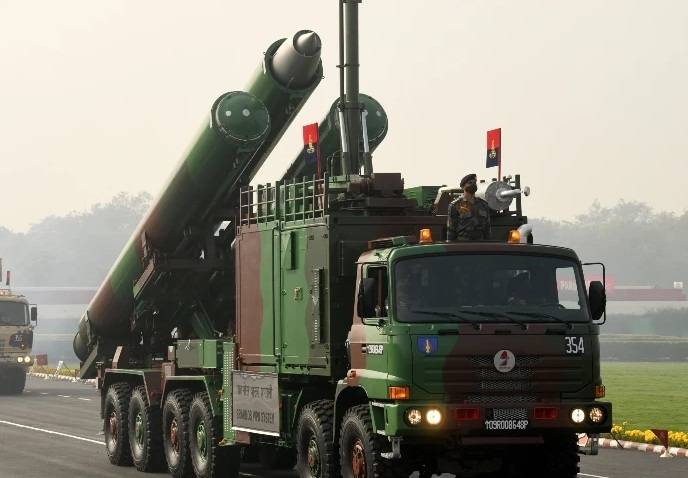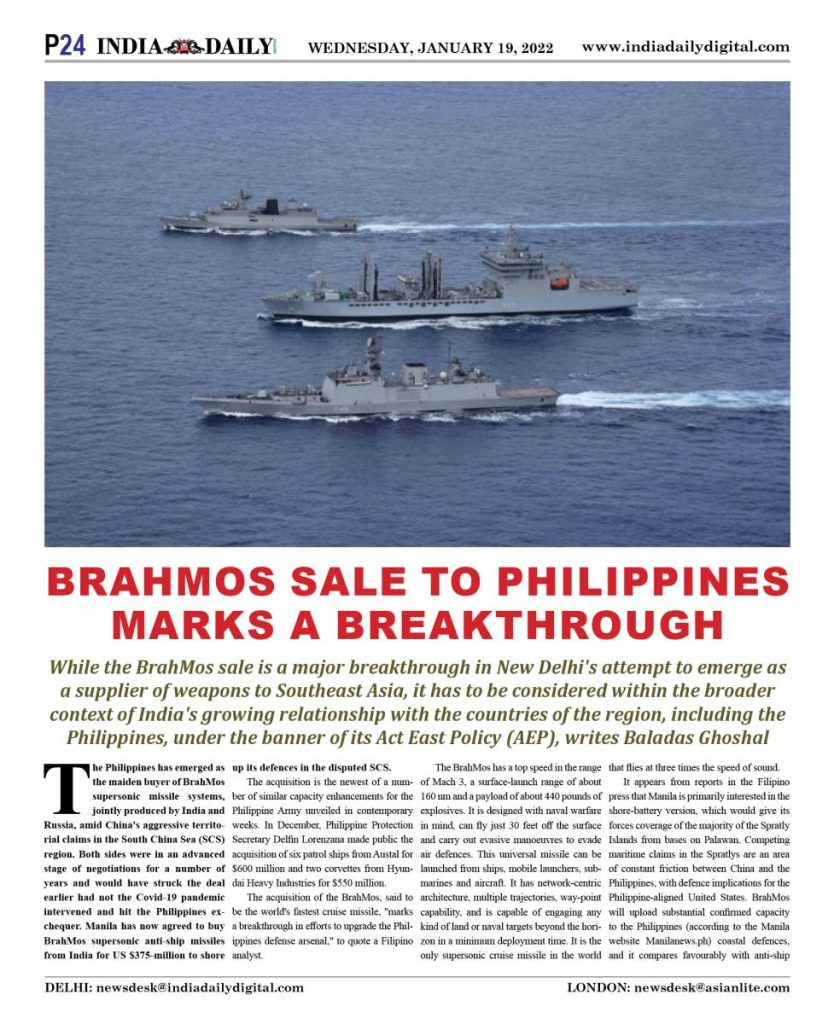While the BrahMos sale is a major breakthrough in New Delhi’s attempt to emerge as a supplier of weapons to Southeast Asia, it has to be considered within the broader context of India’s growing relationship with the countries of the region, including the Philippines, under the banner of its Act East Policy (AEP), writes Baladas Ghoshal
The Philippines has emerged as the maiden buyer of BrahMos supersonic missile systems, jointly produced by India and Russia, amid China’s aggressive territorial claims in the South China Sea (SCS) region. Both sides were in an advanced stage of negotiations for a number of years and would have struck the deal earlier had not the Covid-19 pandemic intervened and hit the Philippines exchequer. Manila has now agreed to buy BrahMos supersonic anti-ship missiles from India for US $375-million to shore up its defences in the disputed SCS.
The acquisition is the newest of a number of similar capacity enhancements for the Philippine Army unveiled in contemporary weeks. In December, Philippine Protection Secretary Delfin Lorenzana made public the acquisition of six patrol ships from Austal for $600 million and two corvettes from Hyundai Heavy Industries for $550 million.
The acquisition of the BrahMos, said to be the world’s fastest cruise missile, “marks a breakthrough in efforts to upgrade the Philippines defense arsenal,” to quote a Filipino analyst.

The BrahMos has a top speed in the range of Mach 3, a surface-launch range of about 160 nm and a payload of about 440 pounds of explosives. It is designed with naval warfare in mind, can fly just 30 feet off the surface and carry out evasive manoeuvres to evade air defences. This universal missile can be launched from ships, mobile launchers, submarines and aircraft. It has network-centric architecture, multiple trajectories, way-point capability, and is capable of engaging any kind of land or naval targets beyond the horizon in a minimum deployment time. It is the only supersonic cruise missile in the world that flies at three times the speed of sound.
It appears from reports in the Filipino press that Manila is primarily interested in the shore-battery version, which would give its forces coverage of the majority of the Spratly Islands from bases on Palawan. Competing maritime claims in the Spratlys are an area of constant friction between China and the Philippines, with defence implications for the Philippine-aligned United States. BrahMos will upload substantial confirmed capacity to the Philippines (according to the Manila website Manilanews.ph) coastal defences, and it compares favourably with anti-ship missiles in use with different navies.
It’s some distance quicker than the US Army’s Tomahawk or the Chinese army’s YJ-18. Emerging hypersonic anti-ship missile technology is beginning to outcompete “slow” supersonic designs, but only Russia and China currently deploy unclassified hypersonic weapons, and only with a limited number of specialized units.
On Friday, Defense Secretary Delfin Lorenzana released a document via social media showing that Manila had approved the acquisition of the land-based missile system for the Philippine Navy from India’s BrahMos Aerospace Private Ltd. “As head of procuring entity (HOPE), I recently signed the Notice of Award for the Philippine Navy Shore-Based Anti-Ship Missile Acquisition Project,” Lorenzana said on Facebook. “Negotiated with the government of India, it includes the delivery of three batteries, training for operators and maintainers as well as the necessary Integrated Logistics Support (ILS) package.”
Export orders by the Philippines are likely to be placed soon and Manila is expected to purchase BrahMos missiles under a “government-to-government deal”. Earlier this year, both sides signed a defence arrangement that would enable export of defence equipment to Manila from India.
The timing of the Filipino announcement for purchase of the missiles is significant, as earlier last week, India said it had successfully test-fired a naval variant of the BrahMos missile from an Indian Navy ship. “Advanced sea to sea variant of BrahMos Supersonic Cruise missile was tested from INS Visakhapatnam today,” India’s Defense Research and Development Organization said in a tweet, adding that the missile hit the designated target ship precisely.

BrahMos Sale to Manila marks a breakthrough
While the BrahMos sale is a major breakthrough in New Delhi’s attempt to emerge as a supplier of weapons to Southeast Asia, it has to be considered within the broader context of India’s growing relationship with the countries of the region, including the Philippines, under the banner of its Act East Policy (AEP). India’s ties with the Philippines have been upgraded over the past few years with the two countries expanding their defence partnership and negotiating a PTA (Preferential Trading Arrangement).
Indian Navy and coast guard ships regularly visit the Philippines and hold consultations with their counterparts. The participation of officers of the armed forces of both countries in various specialised training courses in each other’s countries has intensified. Earlier, India extended a $100-million defence-related LoC to Manila. The Philippines, a US ally for decades, has been keen to diversify sources of its defence hardware including from India. In 2018, a Memorandum of Understanding (MOU) on Defence and Logistics was signed. An MOU on Sharing of White Shipping Information – non-military/non-government shipping vessel information – was inked last year.

Experts in the region take note of the Development
Experts from Southeast Asia and from the US have already taken note of the development. Collin Koh, a Singaporean analyst from the Rajaratnam School of International Studies, pointed out that India is only the second new entrant into the Southeast Asia supersonic anti-ship missile game after Russia. As for the Philippines, it becomes only the third Southeast Asian country after Indonesia and Vietnam, which can boast of an anti-ship supersonic cruise-missile capability, he added. “I’ll say it’s more than a breakthrough – it’s practically a leapfrog,” Koh said via Twitter.
This is the first export order for BrahMos, to quote Derek Grossman, senior defense analyst at the RAND Corp., a US think-tank, who said via Twitter: “China won’t be pleased! It’s official, the Philippines is getting India’s BrahMos.”
Besides Koh and Grossman, many other experts see the BrahMos acquisition as a value-for-money option for a developing country with limited cash for defence spending. “It’s a cost-effective solution for the navy to have a sea-denial capability,” retired navy admiral Rommel Jude Ong, now with the Ateneo School of Government in Manila, who told Benar News from Malaysia in March 2021, when the Philippines and India signed an initial agreement for the deal. “The BrahMos, with a 290-km range, will provide a defensive buffer across a certain extent of the EEZ. It gives the navy a emission-kill’ option in case of conflict,” he said at the time, referring to Manila’s EEZ in the South China Sea.
Back at that time, tensions were running high between Manila and Beijing over the presence of some 200 fishing boats within the EEZ believed to be manned by Chinese militias. The diplomatic standoff went on for months, and although the situation has de-escalated, Philippine officials say that unauthorized Chinese vessels remain a constant presence in Philippine-claimed waters of the SCS. Manila, meanwhile, has been in a race to upgrade and modernize its navy, which until recently had to make do with a fleet of legacy vessels, many of which date back to World War II.
Over the last three years, as we have pointed out earlier, Manila has acquired its first missile-capable warships, a repurposed corvette from the South Korean navy, and two brand new South Korean-made frigates. Last month, Manila signed on to acquire two new corvettes from South Korean-maker Hyundai Heavy Industries for $554 million. Like the earlier corvette and frigates, these will have anti-ship, anti-submarine and anti-air warfare capabilities.

Can Manila stand up to the Chinese Bully?
With the BrahMos in possession, will Manila be able to stand up to China’s threat in case of a real conflict with Beijing? Experts, by and large, are pessimistic in their assessment and believe the Philippines is both outclassed and outnumbered militarily by China when it comes to asserting its territorial rights in the South China Sea. Philippines President Rodrigo Duterte had accepted the same last year when he had said it was better for the Philippines to pursue “diplomatic endeavours” with China over the SCS dispute because “China has the arms” and Manila did not.
Lorenzana also had admitted that the Philippines was “not yet 25 per cent” of the way to achieving minimum credible defence capability. Some experts are critical of Manila’s decision to go for the BrahMos because the country doesn’t have the required infrastructure to ensure that purchases are maintained and manpower is trained to maintain the systems. Some even go to the extent of suggesting that the country doesn’t have a budget to configure the ships to launch them. Leaving aside the sceptics, the procurement of the BrahMos will surely boost the morale of the Philippines Navy to deal with China in future over its possessions in their EEZ. More importantly, once countries like Indonesia and Vietnam also eventually go for the BrahMos, it will be a game changer and embolden all of them to look Beijing in the eye.
(Baladas Ghosal is a former Professor and Chair in Southeast Asian Studies, Jawaharlal Nehru University &Secretary General, Society for Indian Ocean Studies)
(The content is being carried under an arrangement with indianarrative.com)

